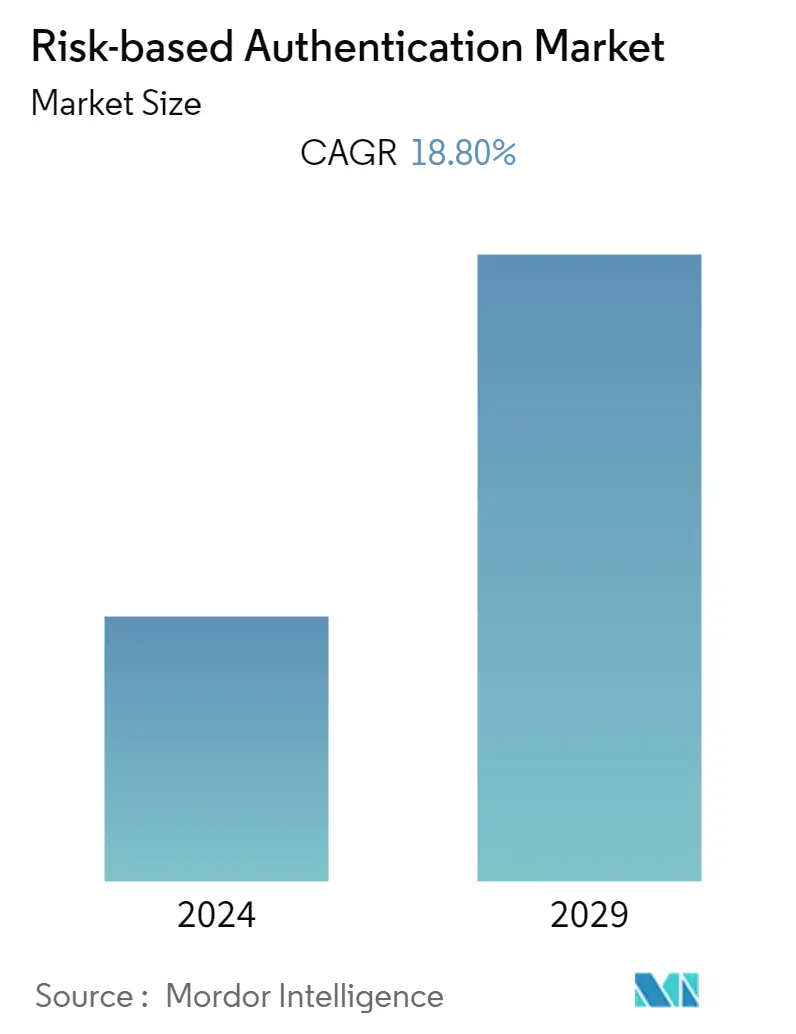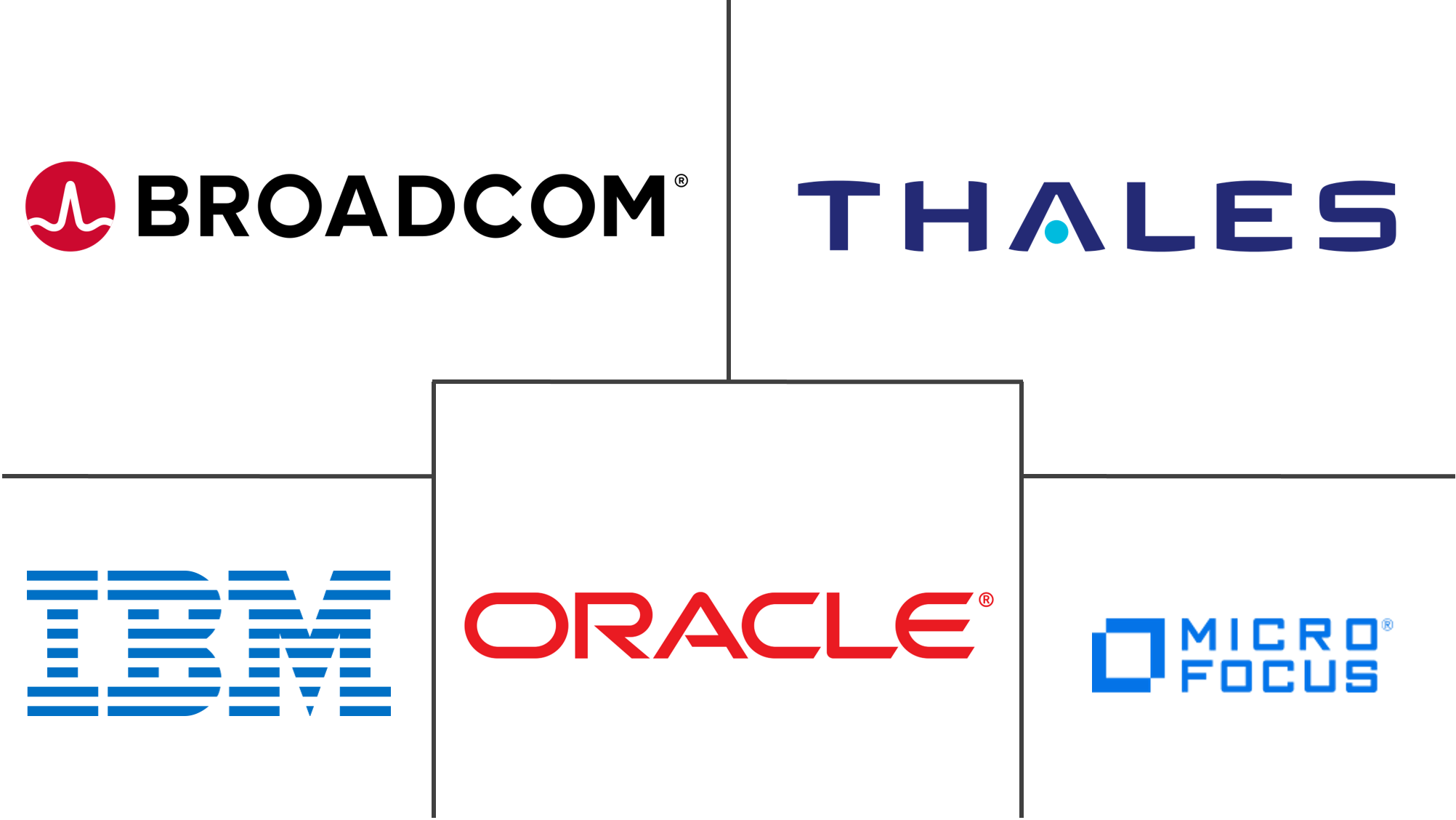Market Size of Risk-based Authentication Industry

| Study Period | 2019 - 2029 |
| Base Year For Estimation | 2023 |
| CAGR | 18.80 % |
| Fastest Growing Market | Asia Pacific |
| Largest Market | North America |
| Market Concentration | Low |
Major Players
*Disclaimer: Major Players sorted in no particular order |
Risk-Based Authentication Market Analysis
The global risk-based authentication market (henceforth referred to as the market studied) was valued at USD 3.23 billion in 2020. It is expected to reach USD 9.41 billion by 2026, registering a CAGR of 18.8% during 2021-2026 (henceforth referred to as the forecast period).
- The COVID-19 pandemic has led to significant growth in fraudulent activities across the globe. According to the Federal Trade Commission, in March 2021, more than 217,000 Americans had filed a coronavirus-related fraud report since January 2020, with losses to Covid-linked fraud totaling USD 382 million. Similarly, the Consumer Financial Bureau fielded 542,300 fraud complaints in 2020, a significant 54% increase compared to 2019.
- Furthermore, according to the Association of Certified Fraud Examiners or ACFE, due to the pandemic, the cyber fraud risk significantly increased from 45% in May 2020 to 47% in August 2020. In addition, it is expected that an increase in cyber fraud risk is expected to reach 60% over the next 12 months.
- Digital channels are becoming imperative as consumers interact with businesses and each other. In the digital world, to accommodate their customers and better manage their organizations, companies are becoming increasingly dependent on a web of systems, both on and off their networks. Such systems assist in managing, storing, and transmitting various information, such as financial accounts, intellectual property, personally identifiable information, transaction records, and others.
- In support of this, various organizations are increasingly adopting automation solutions to enable fast workflow and analyze the work processes to improvise the areas that challenge the company's progress. This has resulted in a massive shift from traditional storage and analytics to cloud-based infrastructure and storage technologies. According to a Flexera 2021 State of the Cloud Report, based on a survey of 750 IT professionals, 92% of the respondents have a multi-cloud strategy, while 82% have a hybrid cloud strategy. About 36% of enterprises reported that their annual spend exceeded USD 12 million, and 83% said that cloud spend exceeds USD 1.2 million per year.
Risk-Based Authentication Industry Segmentation
The scope of the current publication of the risk-based authentication market includes revenue generated by different solutions and services which offer Risk-based authentications.
Risk-based authentication (RBA) is a non-static authentication system that takes into account the profile of the user that is requesting to access the system in order to determine the risk profile associated with that transaction. These systems evaluate the credentials when a person attempts to access an application, database, or any other secure resource.
The scope of the study also covers the trends, revenue, and forecasts for different end-user verticals such as banking and financial services, retail, IT, and telecommunications, among others.
The revenue generated through standalone Multi-factor authentication and other authentication solutions and services is not considered as part of the study.
| By Offering | |
| Solution | |
| Service |
| By Deployment | |
| On-premise | |
| Cloud |
| By End-user Vertical | |
| Banking and Financial Services (BFSI) | |
| Retail | |
| IT and Telecommunication | |
| Government | |
| Healthcare | |
| Other End-user Verticals |
| By Geography | |
| North America | |
| Europe | |
| Asia Pacific | |
| Latin America | |
| Middle East and Africa |
Risk-based Authentication Market Size Summary
The risk-based authentication market is experiencing significant growth, driven by the increasing need for robust security measures in the digital landscape. The shift towards digital channels, accelerated by the COVID-19 pandemic, has heightened the risk of cyber fraud, prompting organizations to adopt advanced authentication solutions. Companies are increasingly relying on cloud-based infrastructure and automation to manage and secure sensitive information, such as financial accounts and personally identifiable information. This transition is particularly evident in the banking and financial services sector, where digital banking and remote transactions have necessitated more sophisticated authentication mechanisms to protect against cyber threats. Regulatory bodies have also mandated the use of multi-factor authentication to safeguard access to sensitive data, further fueling the demand for risk-based authentication systems.
North America leads the market, with the United States being a major contributor due to its extensive reliance on digital networks and cloud technologies. The region's high incidence of data breaches has prompted businesses to invest in robust authentication methods to mitigate security risks. The competitive landscape is characterized by intense rivalry, with major players engaging in strategic investments to enhance their market presence. Despite the competition, the market is poised for continued growth, offering opportunities for innovation and expansion. Companies like IBM, Broadcom, and Oracle are actively developing and integrating advanced authentication solutions to meet the evolving security demands of various industries.
Risk-based Authentication Market Size - Table of Contents
-
1. MARKET INSIGHTS
-
1.1 Market Overview
-
1.2 Industry Attractiveness - Porter's Five Forces Analysis
-
1.3 Technology Snapshot
-
1.4 Assessment of Impact of COVID-19 on the market
-
1.5 Market Drivers
-
1.5.1 Growing Data Breaches and Cyber Attacks across Key End-user Verticals
-
1.5.2 Adoption of BYOD Trends in Enterprises
-
-
1.6 Market Restraints
-
1.6.1 Growing Pressure to Update Risk Scores in line With Evolving Cyber-security Threats
-
-
-
2. Market SEGMENTATION
-
2.1 By Offering
-
2.1.1 Solution
-
2.1.2 Service
-
-
2.2 By Deployment
-
2.2.1 On-premise
-
2.2.2 Cloud
-
-
2.3 By End-user Vertical
-
2.3.1 Banking and Financial Services (BFSI)
-
2.3.2 Retail
-
2.3.3 IT and Telecommunication
-
2.3.4 Government
-
2.3.5 Healthcare
-
2.3.6 Other End-user Verticals
-
-
2.4 By Geography
-
2.4.1 North America
-
2.4.2 Europe
-
2.4.3 Asia Pacific
-
2.4.4 Latin America
-
2.4.5 Middle East and Africa
-
-
Risk-based Authentication Market Size FAQs
What is the current Risk-based Authentication Market size?
The Risk-based Authentication Market is projected to register a CAGR of 18.80% during the forecast period (2024-2029)
Who are the key players in Risk-based Authentication Market?
IBM Corporation, Broadcom Inc. (CA Technology Inc.), Oracle Corporation, Thales Group (Gemalto NV) and Micro Focus International plc are the major companies operating in the Risk-based Authentication Market.

